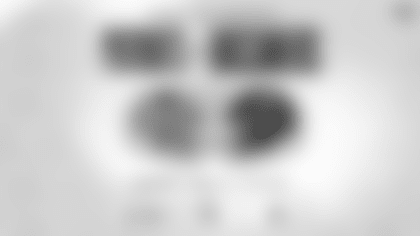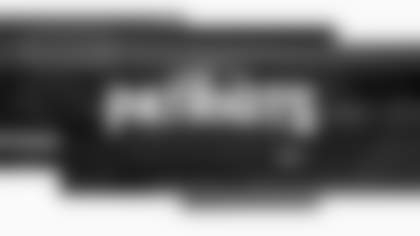The Patriots are heading down to South Beach for their second divisional matchup with the Dolphins at Hard Rock Stadium on Sunday.
After a one-score loss to the Rams, the focus for New England is progress over results from outside the playoff picture at 3-8. In some ways, this season with a first-year head coach, EVP of Player Personnel, and rookie quarterback was always going to end up here, where laying a solid foundation for the future would trump the team's record.
Along those lines, we've seen positive signs from QB Drake Maye and the offense to be optimistic about that group. With the rookie quarterback as their starter, the Patriots are averaging 19.4 points a game while generating 0.01 expected points added per drop-back, ranking 21st in EPA since Maye took over compared to 29th in the first five weeks (-0.16).
However, it's been a roller coaster on the other side of the ball. Following their best performance of the year in Chicago, New England's defense had arguably its worst showing in a 28-22 loss in Week 11. On the season, the Pats rank 30th in DVOA on defense, while they surrendered a season-high 7.9 yards per play to Los Angeles.
With the defense looking for consistency while the offense continues to trend upward, the big-picture theme this week is learning not to lose before you can win. Recently, the Patriots are letting winnable games slip away because they're making critical mistakes at crucial times, which, unfortunately, is often how teams get to 3-8 in the NFL.
The question for the Patriots is, can they avoid late-game miscues while pulling the right coaching levers to win close games? This week, the Patriots will try to pull off a win against a quarterback who is 6-0 in his career vs. New England. Miami's offense is back on track with a healthy Tua Tagaviola, who ranks fifth in EPA per drop-back this season in a scheme that presents problems. With Tagaviola, Miami averages 23.5 points in six Tua starts. Now that they have their quarterback, the Dolphins (4-6) are looking to make a late playoff push.
To hammer home the bigger picture point, the old cliche is that coaches lose games while players win them. After the defense struggled to slow down the Rams offense last week, New England's coaching staff has to set its players up for success against a divisional opponent that has their number.
Let's break down the chess match between the Patriots and Dolphins in Miami on Sunday.
Patriots Offense vs. Dolphins Defense: Can the Short Passing Game Work Again This Week?
Starting on the offensive side of the ball, this week is an interesting battle of wits with offensive coordinator Alex Van Pelt going against Dolphins defensive coordinator Anthony Weaver.
After taking over for veteran DC Vic Fangio this season, Weaver is running a zone-based defense that's similar to the one New England just faced last week. Like the Shanahan tree on offense, Baltimore's defensive scheme popularized by now-Seahawks head coach Mike Macdonald is popping up everywhere. The 44-year-old Weaver is also another player-turned-coach, spending seven seasons in the NFL with the Ravens and Texans.
Before taking a job in Miami, Weaver spent the last three years with the Ravens, working for Macdonald in the previous two seasons. As a result, the Dolphins major in zone pressure schemes, playing zone at the ninth-highest rate (75.6%) in the league while dialing up creeper pressures on 6.3% of those plays, the fourth-highest rate in the NFL.
Although his team lost the game, Raiders QB Gardner Minshew had a similar statistical performance as Maye last week. Maye was more efficient in his drop-backs, posting a 73.7 QBR compared to a QBR of 50.2 for Minshew, but there were similarities to how they both produced 282 passing yards and two touchdowns with one pick each.
| Stats, Week 11 | Drake Maye | Gardner Minshew |
|---|---|---|
| Comp-Att | 30-40 | 30-43 |
| Passing Yards | 282 yards | 282 yards |
| TD-INT | 2-1 | 2-1 |
| Avg. Air Yards | 5.6 yards | 3.7 yards |
On his 43 passes, Minshew attempted 36 throws under 10 air yards with an average target depth of 3.7 yards. He was productive on those short passes, averaging 7.2 yards per attempt while completing 80.6% of those passes. Maye, on the other hand, went 27-33 for 240 yards on throws under 10 yards with an aDoT of 5.6 yards vs. the Rams.
As we'll get to, the Dolphins coverages can be exposed with a similar game plan as the Patriots used vs. the Rams. Miami doesn't have as potent a pass rush as LA's, but they rank a respectable 11th in pressure rate and like to run exotic pressure schemes to pressure the QB. They also have two disruptive interior rushers in Calais Campbell and Zach Sieler, but besides first-rounder Chop Robinson, who has been better lately, the edges don't necessarily scare you.
The wildcard is how Weaver will game plan this Patriots offense. After watching Maye pick apart the Rams blitzes and underneath coverages, it's possible that the Dolphins play things like they did in Week 5 vs. Jacoby Brissett. Maye is a more dynamic playmaker than Brissett, but the Pats rookie just proved he can be successful against soft coverage.
Statistically, the Dolphins only play man coverage 28% of the time and only press receivers on 16.6% of their opponent's pass plays (23rd). But, in Week 5, they played more man coverage than their season average vs. Brissett (40%). The plan was to play blitz-man in high-leverage situations to force Brissett and the Pats wideouts to beat tight coverage downfield.
That strategy worked in a 15–10 win for Miami in Foxboro. Now, the question is, does Maye's mobility and deep passing ability scare off the Dolphins from using a similar strategy?
If it does, the Raiders provided answers for the Patriots. Like the mesh concept above, Vegas attacked off-coverage with a few repeat plays. The Raiders hit mesh a few different ways, hitting a crosser into the zone void and throwing the rail route out of the backfield vs. man.
When the Dolphins ran their exotic pressure schemes, the Raiders were able to get the ball out of Minshew's hands quickly to receivers being covered by defenders way off the line of scrimmage. Above, Miami runs a simulated pressure. Although the defenders pop out of the rush into short zones, it's cover zero in the backend, so Minshew distributes the ball into the flat on the slant-flat combination, which causes enough traffic against man coverage to get TE Brock Bowers free for a 23-yard touchdown.
Lastly, Vegas also had success with quick-game concepts. Here, the Dolphins run a five-man pass rush like they did in the Brissett example, except with zone coverage in the secondary. With a six-man zone distribution, the running back's route moves the short zone defender to open the curl window, and Minshew takes the easy money.
Bowers had a monster performance with 13 catches for 126 yards and a touchdown. Furthermore, Miami ranks 26th in drop-back success rate on throws between the numbers (61.1%). On paper, this is a solid matchup for the Patriots, who can use tight ends Hunter Henry and Austin Hooper like Bowers and have inside receivers like DeMario Douglas to run into the voids that are typically there in the Dolphins coverages.
Again, this game then comes down to the chess match between Van Pelt and Weaver: will Weaver play his brand of defense or challenge the Patriots to beat him deep? The film and stats suggest the Dolphins should do the latter, but time will tell if they're savvy enough to adjust.
Patriots Defense vs. Dolphins Offense: Beware of Repeat Plays, Motion and Speed
Moving over to the other side of the ball, the Dolphins offense is a different beast when Tagovailoa is at quarterback, both against the league as a whole and vs. the Patriots.
In three games since 2022, Tagovailoa has completed 68.5% of his passes with five touchdowns to two interceptions while adding +0.22 expected points vs. the Patriots. The Pats haven't had any answers against the Dolphins offense when Tua, Tyreek Hill, and head coach Mike McDaniel are all participating. So, what do they do this time?
Under McDaniel, Miami runs a highly nuanced scheme, which is the main reason it has only worked with Tua. The Dolphins motion at a league-high rate (82.7%) and major in condensed formations (45.6%, sixth). They also run their offense out of heavy personnel groupings, only playing three receivers on 37.2% of their plays (30th). Instead, Miami toggles between two-back formations and two-tight end sets, much like McDaniel's mentor, Kyle Shanahan, rather than McVay's three-reciever heavy offense.
My biggest fear in this matchup is that the Patriots will match the Dolphins heavy grouping with base defense, which they've done this season: they cannot do that. The main reason they can't play base is, of course, Miami's team speed on offense. You cannot put an extra linebacker on the field against Hill, Waddle, Achane, Washington, etc. Last week, New England played base defense on 49% of the Rams offensive plays, allowing 10.3 yards per play on 25 snaps in base packages. McVay got the Pats in base defense and threw the ball, averaging 18.1 yards per pass play on 12 attempts. On the season, the Pats are 30th in yards per play in base defense (6.3) while playing 43.8% base defense rate (second-highest in the NFL).
The other element to this matchup is that the Patriots must have a better plan this week against motion. The Rams averaged 9.2 yards per play when they motioned, compared to a 4.5-yard average when there wasn't any motion on the play. Despite their high motion rate, New England looked unprepared for LA's motion concepts, and guess what, the Dolphins are about to do the exact same thing on Sunday.
As we get into Miami's scheme, it's also worth noting that their offense has evolved from thriving in the deep passing game with Hill and Waddle to a more quick-strike attack built around yards after the catch. This shift is because defenses play two-high safeties vs. Miami, forcing them to nickel and dime down the field rather than throw bombs. The Dolphins see two-high safety structures on 67.2% of their offensive plays, the highest rate in the NFL, while only 7.3% of Tua's passes have traveled over 20 air yards. Tua's average target depth is 5.6 yards, the league's lowest air yards per attempt.
Rather than the vertical passing game we're accustomed to seeing with this offense, it's been more about the run game and yards after the catch, with De'Von Achane and old friend Jonnu Smith emerging defenses keying on the two receivers.
As is the case with all Shanahan tree offenses, the Dolphins start by getting the defense flowing horizontally with their run game. Miami will run zone schemes from under-center and pistol formations to attack the defense outside the tackles. Plus, the Dolphins use their speedy receivers on jet sweeps/end-arounds, all to get the defense stretched out.
Then, McDaniel starts building in play-action concepts off those outside runs. Miami marries those run actions to create passing windows between the numbers. By stretching out the defense, the play fakes create voids over the middle of the field. They'll half-boot off toss-actions, fully bootleg, and use pistol-action to get the ball out of Tua's hands faster.
As they did in the final play-action clip, the Dolphins use motion to create holes in the defense. Rather than throwing to the motion man, Miami's motions are typically used to open holes and then throw the ball into those voids. In this example, Waddle motions into the formation and then releases over the ball, which creates a huge passing window for Tua to throw one of his patented anticipatory throws to Hill on a spray post.
In the drop-back game, McDaniel will use motion to create favorable leverage for Tua to hunt matchups when defenses play man-to-man. This time, the short motion by Achane out of the backfield declares that the safety in the box has the back in a two-man structure. Achane then releases on the angle route with the middle of the field open for easy money.
New England's defense has its work cut out for it against the Dolphins. Miami's scheme has a lot of similarities to Los Angeles's offense, which just averaged 7.9 yards per play in a 28-22 win in Foxboro. In one practice week, the Pats must find better solutions to handle motion and limit explosive plays, a difficult task against a big-play offense in Miami.
The onus is on head coach Jerod Mayo and defensive coordinator DeMarcus Covington to better prepare the players for the Dolphins offense.
Key Matchups
CB Christian Gonzalez vs. Dolphins WR Tyreek Hill
After taking heat for having Gonzalez cover the boundary rather than shadowing Kupp or Nacua, the Patriots have routinely put Gonzo on Hill in matchups with Miami. Maybe that's because Hill often plays the 'X' on the boundary himself, so it works out that way. But, in Week 5, Gonzo covered Hill on 21 of his 29 routes, holding the Dolphins star to three catches for 55 yards on six targets with a pass breakup. Expect to see these two square off again in what has been a great duel since Gonzalez's rookie season.
CB Marcus Jones vs. Dolphins WR Jaylen Waddle
In the past, the Patriots haven't shadowed Waddle in the same way that Gonzalez has traveled with Hill. In Week 5, Waddle saw a mix of Gonzalez (8 snaps), Marco Wilson (8), and 10 combined reps against the Joneses. However, my guess is that they match speed-on-speed with the younger Jones tracking Waddle while possibly playing Jonathan Jones at safety to help keep the lid on the defense. This is a nice test to see if Marcus can be this defense's primary field or nickel corner going into next season.
Patriots Interior O-Line vs. Dolphins DTs Calais Campbell and Zach Sieler
Besides veteran CB Jalen Ramsey, the Dolphins two best defenders are Campbell and Sieler, who both play on the interior of their D-Line. The duo has combined on 46 pressures and 24 run stuffs this season, and they win in different ways. Campbell is still playing at a high level with brute force, using his huge frame to dent pockets and get into passing lanes. Sieler is a high-motor rusher with excellent snap quickness, like Rams rookie DT Braden Fiske, who had a strip sack last week. Specifically, I'm looking at LG Michael Jordan and C Ben Brown in this game after rough performances in a tough matchup a week ago.
RT Trey Jacobs vs. Dolphins EDGE Chop Robinson
Although they'll move the rookie around some, Robinson, the 21st overall pick in the 2024 draft, mainly rushes over the right tackle. The Penn State product is shot out of a cannon with excellent first-step quickness and bend to corner the edge. Over the last month, Robinson ranks fifth among edge rushers with 18 pressures. He's starting to figure it out, while Jacobs struggles at times with a short corner. Its a tough matchup for Jacobs.
DISCLAIMER: The views and thoughts expressed in this article are those of the writer and don't necessarily reflect those of the organization. Read Full Disclaimer












































